How To Make Natural Dyed Easter Eggs – Easy to Follow Directions
This post and its photos may contain affiliate links, view our disclosure policy.
I decided to try my hand at natural dyed Easter eggs this year.
I pulled food and spices out of the cabinet and fridge and got busy trying different things to see what works and what doesn’t.
I remember my mom and grandma making natural dyed Easter eggs with red onion skins when I was child, but I don’t remember how they dyed the eggs using them.
A little research and I had an idea of how to go about dyeing the eggs using natural ingredients.
Natural Dyed Easter Egg Ingredients
I used the following items to dye eggs:
- Coffee
- Tea
- Red Onion
- Red Cabbage
- Turmeric
- Yellow Onion
- Blueberry + Cranberry Juice
- Blueberry
- Chili Powder
- Cayenne Pepper
Alan is quite the trooper. He came home and saw my little experiment going on in the kitchen and just took it in stride.
These bowls took up about 75% of my counter space so nothing else would be happening in the kitchen (ie: cooking dinner) until the experiment was over.
The items that you see at the far left of the image are some of the ingredients for my super tonic that I’ll be sharing with you soon.
How Long Does It Take to Make These Easter Eggs
I left the eggs in the solution for 2.5 hours, 5 hours, and 9 hours just to see what kind of colors occurred over long periods.
Easter Eggs After 2 1/2 Hours
At 2.5 hours some of the eggs could have been considered done, but I wanted to see the results from leaving them in longer.
Easter Eggs After 5 Hours
At five hours the red cabbage eggs are turning a beautiful color blue.
Easter Eggs After 9 Hours
Nine hours was too long. I could have been done at 2.5, perhaps sooner, for most of the eggs and 5 hours for the turmeric and red cabbage.
Some of the eggs could have come out of the solution right away and some others needed at least the full 5 hours. I’m sharing the “how to” for each egg below.
Here are the eggs after 9 hours in the liquid plus air drying time.
The only exception is the two different blueberry eggs in the chart.
The one in the upper right corner is blueberry and cranberry juice after nine hours and the eggs in the lower left is eggs just rolled in blueberry juice and removed immediately.
The yellow onion was also only left in for a couple hours.
I completed two sets of eggs the next day so didn’t include them in the 9 hour experiment.
I displayed the eggs in these awesome martini glasses and LOVED how they looked.
I just added a bit of Spanish moss to nestle them on.
NATURAL DYED EASTER EGGS INSTRUCTIONS
I used two different methods to make these eggs; a cold method and a hot method.
For the majority of these eggs I used the cold method. Just mix the ingredients in a non-staining bowl (ie: glass is great) and add hard boiled eggs. Let them sit until the desired color is achieved.
For the hot method I added the ingredients and raw eggs to a non-aluminum pan, brought the mixture to a boil, reduced the heat and let simmer for 15 minutes. Remove from heat and let sit until eggs achieve the desired color.
The method used is noted in the directions below.
NOTE: The eggs may take on the flavor of the coloring agent.
HOW TO USE YELLOW ONION SKINS FOR NATURAL DYED EASTER EGGS
1 cup of water, room temp + dry peel from one medium yellow onion + 1/8 cup of white vinegar (cold method).
This combination will color one egg. Instead of throwing dry onion skins away during the year you can save them to color Easter eggs in the Spring.
The little dash of blue you see on the left side of the egg is from a rogue blueberry that ended up in the pan.
HOW TO USE TEA FOR NATURAL DYED EASTER EGGS
3 tea bags+1 cup steaming hot water+1/8 cup of white vinegar (cold method).
Steep the tea bags to make very strong tea.
Add eggs and let sit in water until desired color is achieved.
HOW TO USE BLUEBERRIES FOR NATURAL DYED EASTER EGGS
1/2 cup frozen blueberries (thawed & smashed) + 2 Tablespoons white vinegar (cold method).
Roll eggs until color is achieved and then remove.
These took just a couple minutes to make.
HOW TO USE RED ONION SKINS FOR NATURAL DYED EASTER EGGS
1 Cup water + dry peel from 1 large red onion + 1/8 cup white vinegar (hot method).
This combination colored 2 eggs.
As with the yellow onion skins, red onion skins can be saved throughout the year as well.
HOW TO USE TURMERIC FOR NATURAL DYED EASTER EGGS
2 cups warm water+ 3 tablespoons turmeric + 1/8 cup white vinegar (cold method).
This ended up being one of my favorite colors.
The turmeric creates a beautiful yellow color that reminds me of spring.
The darker areas are where the egg sat on undissolved turmeric.
HOW TO USE CAYENNE PEPPER FOR NATURAL DYED EASTER EGGS
2 cups warm water + 3 tablespoons cayenne pepper + 1/8 cup white vinegar (cold method).
The speckles are created from the undissolved cayenne pepper.
HOW TO USE RED CABBAGE FOR NATURAL DYED EASTER EGGS
1/2 of red cabbage head, chopped up + 1/8 cup white vinegar + 4 eggs + enough water to cover eggs (hot method).
I love, love, love this color.
The egg with white speckles/lines was created by wrapping an egg in a cabbage leaf and securing with a rubber band and then adding to pan with the other ingredients.
HOW TO USE BLUEBERRY/CRANBERRY JUICE FOR NATURAL DYED EASTER EGGS
1 cup frozen blueberries, thawed and smashed, 1/2 cup 100% cranberry juice + 1/8 cup white vinegar (cold method).
I’m not sure how much impact the cranberry juice had on the color but I needed some liquid for the eggs to sit in and I didn’t want to dilute it with water so I used some cranberry juice.
9 hours was too long, in my opinion, for these eggs.
I thought they were perfect around 2.5 hours for a light spring color.
HOW TO USE CHILI POWDER FOR NATURAL DYED EASTER EGGS
2 cups warm water + 3 tablespoons chili powder + 1/8 cup white vinegar (cold method).
Eh, wouldn’t make these again.
The color reminded me a lot of brown eggs.
HOW TO USE COFFEE FOR NATURAL DYED EASTER EGGS
1 cup of very strong brewed coffee + 1/8 cup white vinegar (cold method).
This egg was a little darker, but I wiped the egg off after taking it out of the liquid and ended up with this light tan color.
SAFETY NOTE ABOUT CONSUMING THESE EASTER EGGS
Do not eat hard boiled eggs that have been left out for more than 2 hours. Refrigerate hard boiled eggs within 2 hours or less, eat within 1 week! Raw eggs can only be left out for 2 hours or less also.
PIN TO PINTEREST
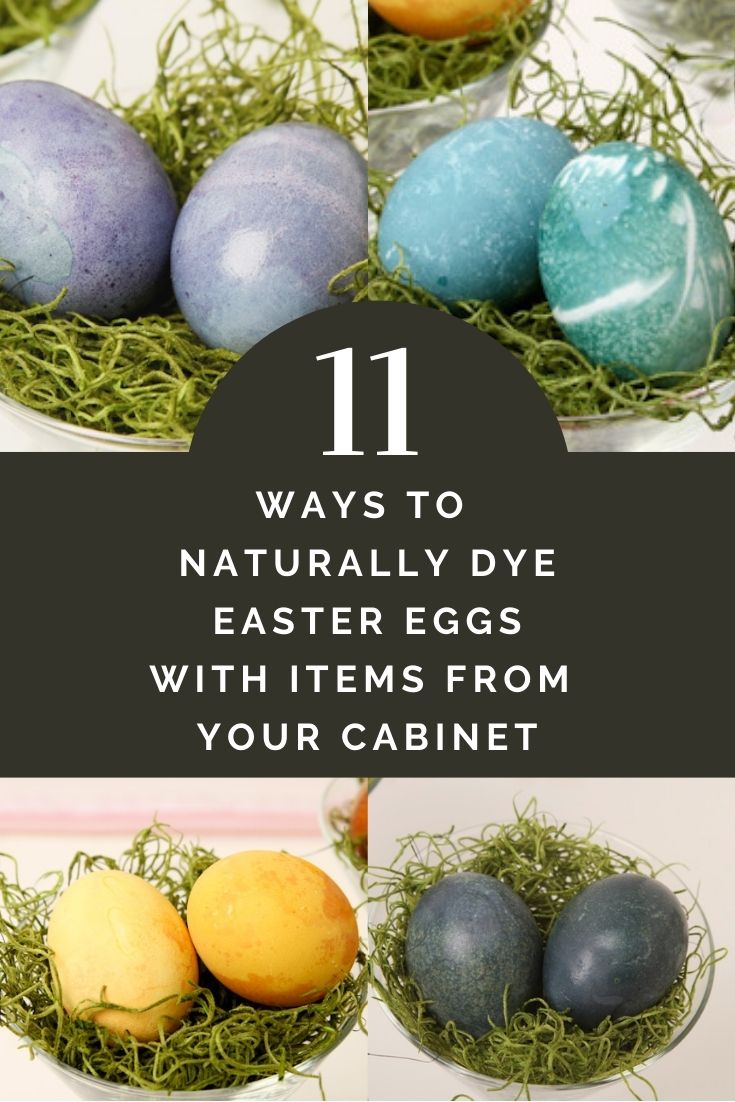
Be sure to check out this fun post for Silk Tie Dyed Easter Eggs:
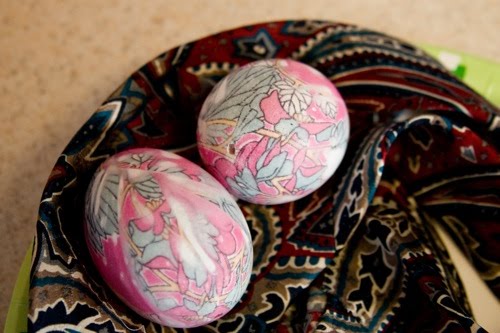
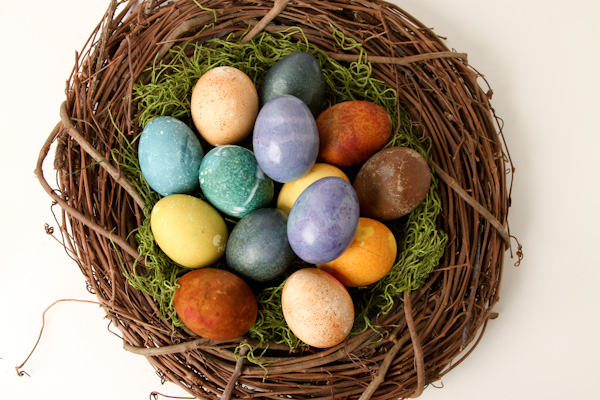

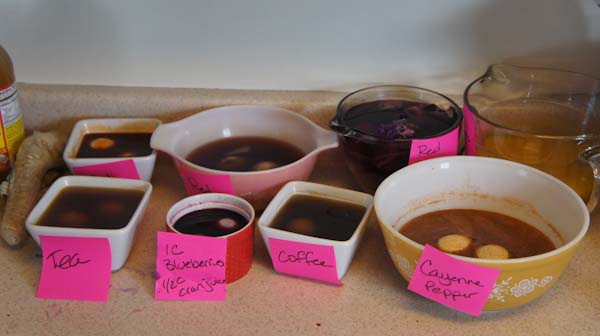
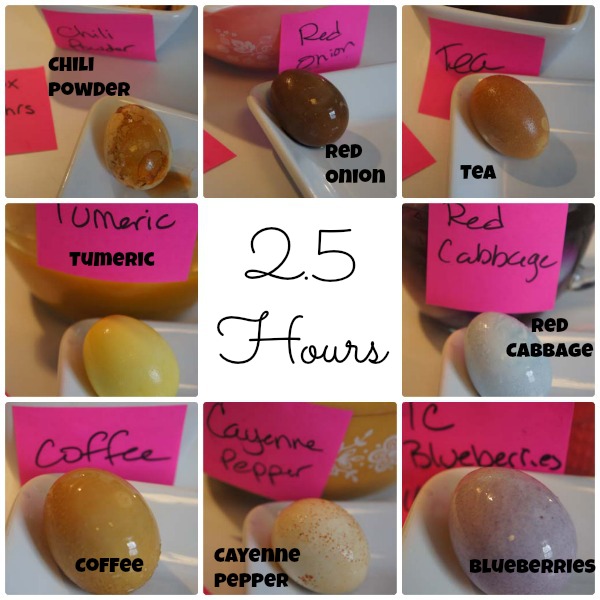
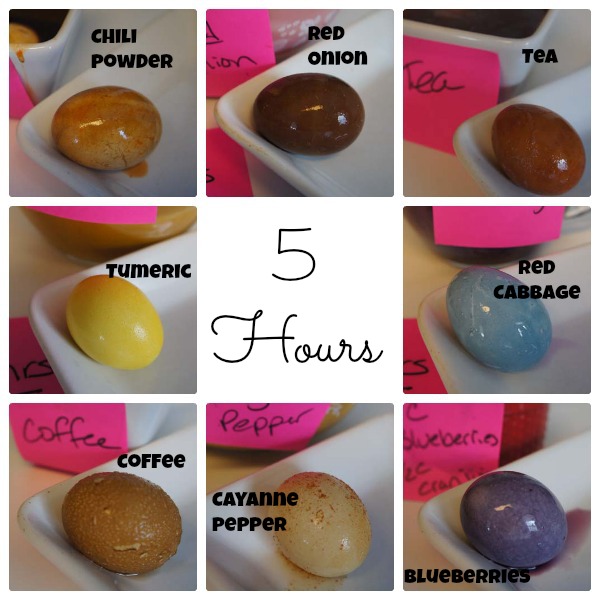
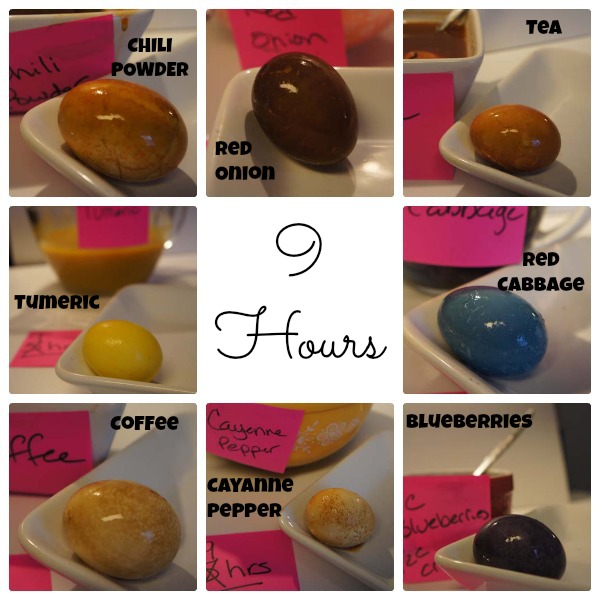
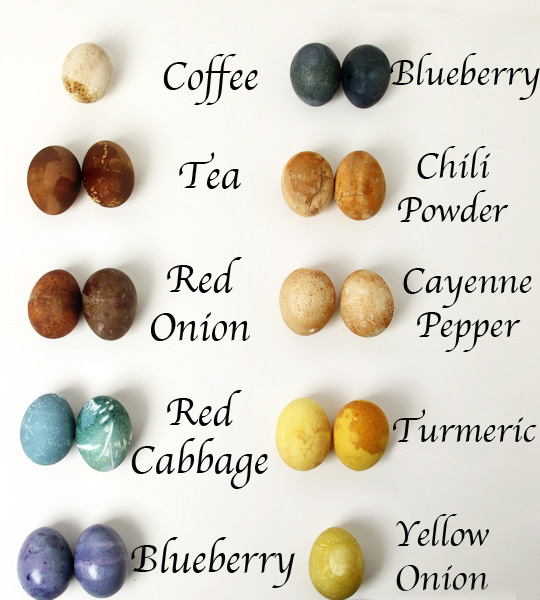
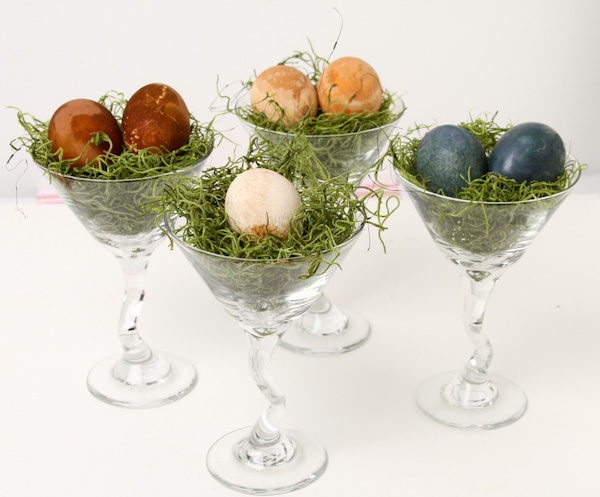
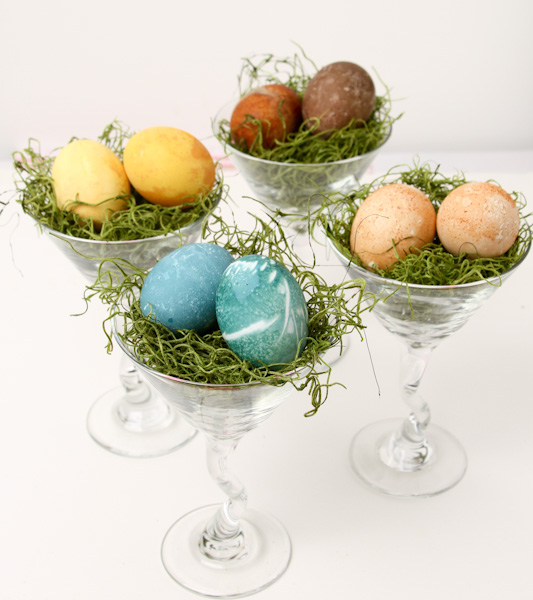
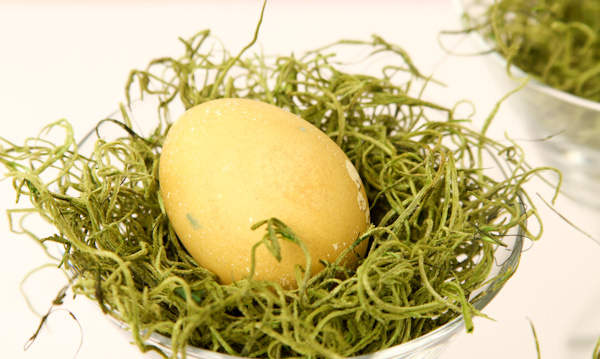
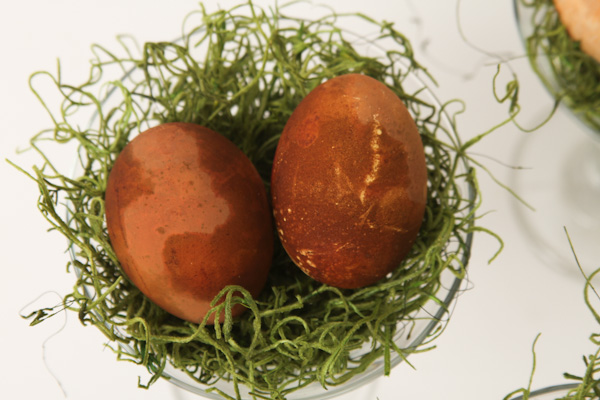
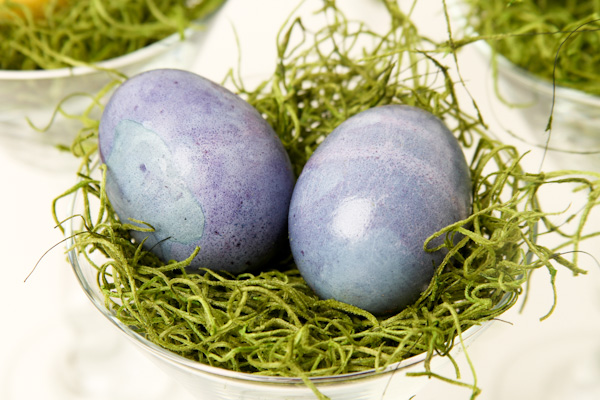
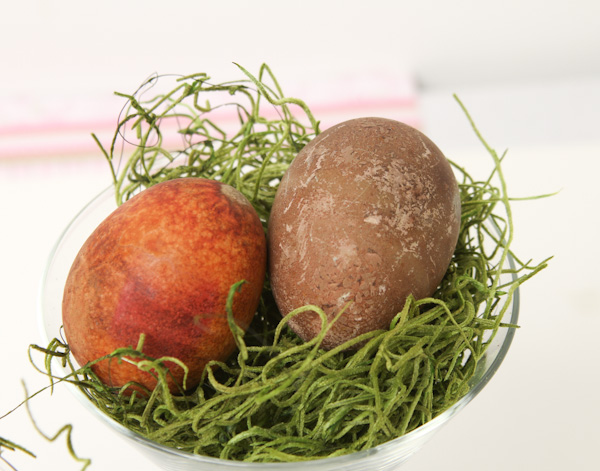
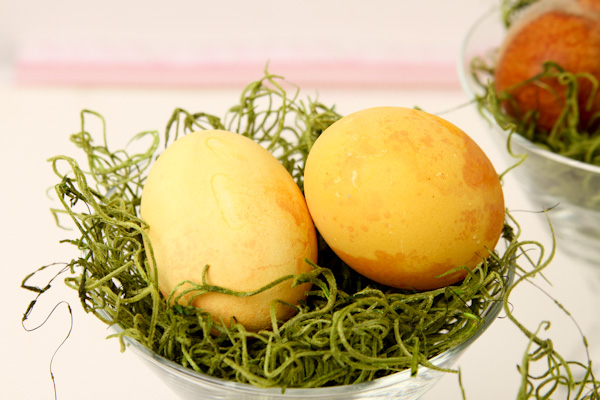
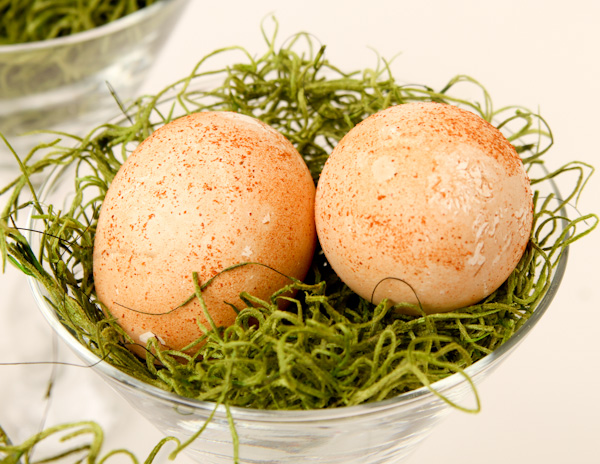
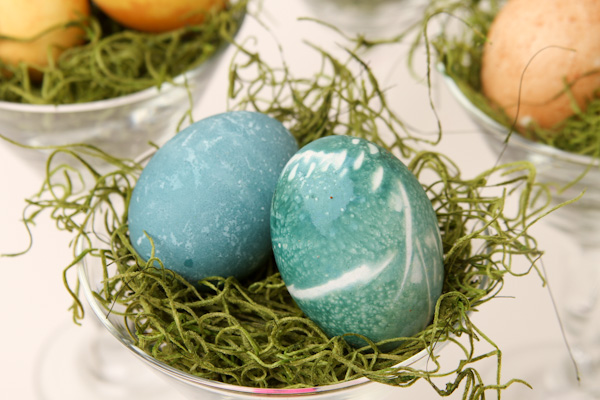
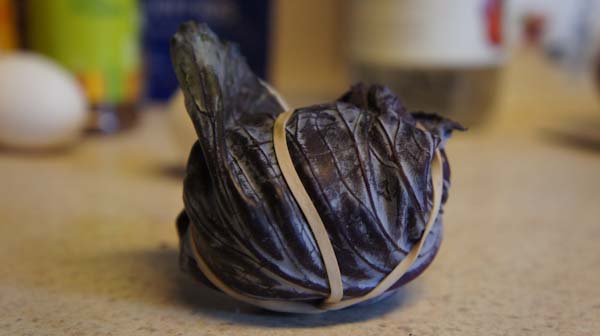
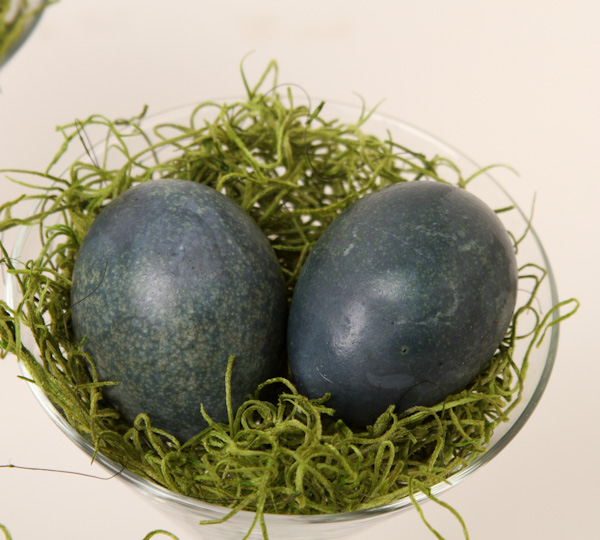
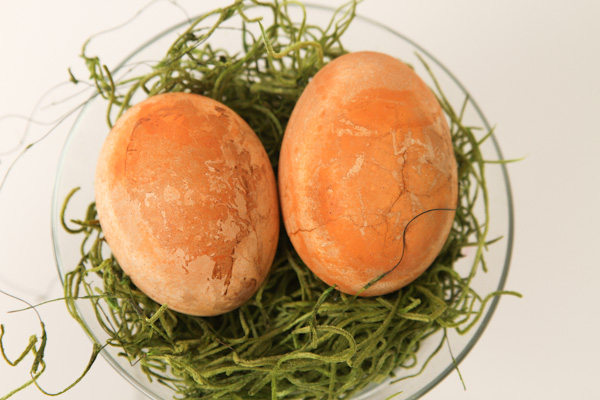
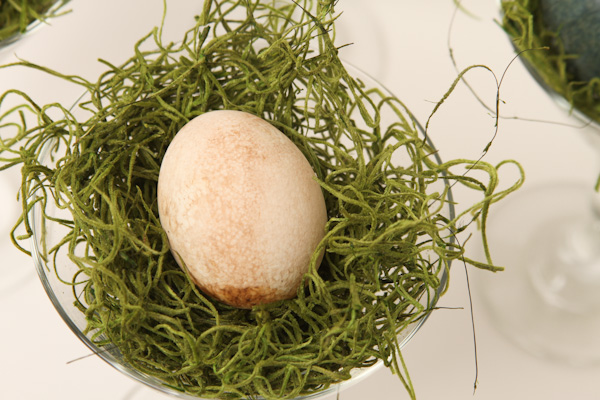
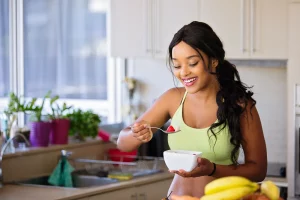
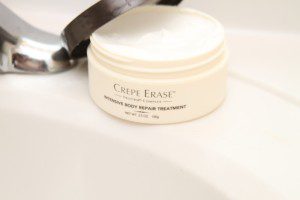

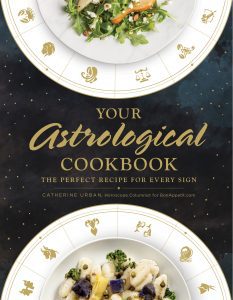




Very nice!! I tried red and yellow onion, and also beet (hot and cold -both methods). I liked very much the results. Next year I hope I will try even other ingredients, I’m thinking of black cherry juice and grapes.
LOVE these! Here’s how mine turned out. I used turmeric, blueberries, Thai tea and saffron. The eggs were in for less than an hour. When I dried them I stamped them with words 🙂 http://nataliezaman.blogspot.com/2013/03/the-eggs-and-i.html
This inspired me since I hate the chemical food dye and am tired of spending $20 on three small tubes of coloring at Whole Foods. Half the fun was finding stuff I thought would dye the eggs. I used frozen beet stock (I knew I’d have a use for that!), blueberries, blackberries, raspberries, turmeric and mustard, turmeric and crushed red pepper (going for orange), crushed red pepper and paprika, tea, and coffee. They’re still steeping but so far the beets and coffee are most colored. Beets are magenta, really cool!
I remember when I was kid boiling eggs with onion skin and tea – 20 years back in one of the Soviet countries. We would also wrap the eggs in a corn leaf – to create random pattern. The best thing is: since it’s all food items, you don’t have to be afraid to actually eat the egg!
Wow! You sure did a lot of work, lovely photos and graphics too. I’ll have to try the red cabbage and blueberries, the blue eggs are lovely. The turmeric ones too. I’ve tried beets and unfortunately, unless you squint or look at it through rose-coloured glasses, the colour comes out in various shades of gray, not a hint of red or pink! I think the calcium carbonate in the egg shells reacts differently with natural dyes, which would otherwise colour natural fibres or food quite nicely. I’m still on the hunt for a tried and true natural red or pink dye for eggs.
Wow I love the natural look of some of these. We might try this.
Could the eggs have sat in the natural dyes in the fridge so that the eggs would not spoil?
I used beet juice
I’m thinking some of these same items can be used to dye natural fibers like wool.
@janet. Not sure if apple cider vinegar will change the colors or not. It’s worth giving it a try.
What if you used apple cider vinegar instead of white? Would it change the colors?
Get ideas to avoid food dye
Janet
Thanks for the great instructions and photos! Your eggs are beautiful!
Because I wanted to use what I had on hand, I tried red pepper, curry powder and frozen blueberries. I so appreciate the ease and simplicity of the cold method. Thank you!
beautiful egss, to dye using red or yellow onion just use a raw egg , wrap some of the onion skin around the egg then wrap apiece of cloth and secure with elastic or you can put inside stocking then cook to make hard boiled egg.you can also keep these eggs for ever. just keep the eggs out of the fridge and allow the yolk to dehydrate on its own. just be careful to not break the egg. i have many eggs that are 10 or 12 yrs old that i display at easter. have fun creating!
Have you tried using beats for some brighter pink/red hues? If you do, let us know! 🙂
Well done! It looks beautiful! ;D
HI DEB FROM DEB! VERRRRYYYY COOOOOLLLLL blog you have & the eggs are eggs-sellent! I wonder if some of the things I’ve done w/ fabric would be applicable? I have dyed fabric in the past with elderberries and also froze them to use at a different time(and wrote on pkg. NOT TO EAT, as I wasn’t too sure they were elderberries at the time), also something that really stains things around here – fresh strawberries. For eggs you could experiment with the intensity by keeping the egg in “strawberry mash” for different times. Fresh blueberries – you’ve already used, along w/cranberries-one of the prettiest reds going.I have used – with great success – dandelion greens for dying fabric. I wonder if a “mash” of greens would yield a great egg dye, too? You’d have to pick them this year, freeze & label for next. My poor husband never knows exactly what he’ll find in the freezer in our garage at different times of the year…but I’m fairly good about labeling.
One great thing for color is the little pistils from the day lilies we have here in abundance in the summer. Yep, I used them to dye silk, they worked quite nicely, and wonder if they would freeze well to use for easter eggs??? Also, a neat thing was to use bleach on my dyed fabrics (spray bottle, paint brush – very diluted and VERY WELL VENTILATED outdoors, for only tiny period of time!!!and I’d never use on a hardboiled egg that I was going to peel and eat!). Something else that reacted w/ fabric and again same high level of caution applies to food & personal safety-is dish washer detergent. It’s more caustic than you think! But these methods worked on fabric and I believe the egg shell would be porous enough to try these tricks too.
Again, only blown out eggs are the best ones to use if you are keeping the cooked egg out of the fridge for any time over an hour. I know the guidelines say 2 hrs is ok, but why chance it? When dying in the past, I have dyed right in the fridge. You probably have to leave things longer, but it’s worth it. I have used farm fresh eggs (I run a farmers’ market in my town)in the past and they seem to dye the best-someone told me it was due to the calcium being “extra good” and there may be something to that.
One fun thing I used to do as a kid was wind rubber bands around the eggs too before dying them, sort of a random tie-dyed look. It is SOOO refreshing to read your blog & I will look forward to more! The photos are GORGEOUS, too! Best Regards and a few High Kicks, xoxodeb in CT
Hi Steve, Great list. thanks for sharing.
Feel free to share the image with a link back to me, but please do not copy my content. Thanks for asking 🙂
I love this post! Just did some, came out beautifully. Saw this article too late, but not for next year: http://www.shopterrain.com/article/how-to-sunprint-easter-eggs/?cm_mmc=broadcast-_-Q12013-_-031713colorfuleaster3-_-mainimage
Wow! I love this post. Thanks for sharing, Debs. Btw, I would like to share this post in my blog and the 6th photo as well. Please let me know if its ok with you.I will provide a link to your blog. Thank you very much.
http://goindigolifestyle.blogspot.com/
Wow! I love this DIY project of yours.I would love to share this post on my blog and also the 6th picture. I will provide a link to your blog and give due credit to your photograph. Please let me know. Thanks.
INDIGO at http://goindigolifestyle.blogspot.com/
Can’t you save those hard boiled eggs and eventually they will dry up inside and you can keep them as long as they get no holes or cracks?
Thank you for your research and willingness to post all your info. I’m going to experiment with First Graders the joys of egg coloring. I can hear their comments now,”This has been the best day ever!”
These look amazing. I am so going to try it out this Easter. Are there any ways to make the natural dyes more intense so you don’t have to dye them so long?
What a cute project! I love it so much that I decided to feature it in our roundup of Easter egg crafts! Check it out here: http://www.favecraftsblog.com/easter-egg-crafts/
Have a great day!
Some other dyes not mentioned:
rhubarb, chamomile and green tea, eggplant skins, apple skins (different colors), paprika (another common pepper spice), carrot, dill seeds, purple grape juice, strawberries, blackberries (purple, not black), henna, prickly pear fruit, and edible colorful flowers such as rose, dandelion, amaranth, orchid, African violets, begonia, lavender, common snapdragon, various daisies, etc. (see a list of edible flowers for use in cake decoration).
Some flowers dye very well, but are poisonous, such as iris.
Grass likely wouldn’t hurt you, and we all know it stains green.
You can wrap eggs in onion skins much like you did with the cabbage and get very fun mottled patterns. I have also wrapped pretty leaves inside the onion skin (e.g. ferns) and boiled, to get a leaf pattern on the egg.
amazing!
I’m sorry but eggs keep far better and longer than some of you give them credit for. As children eggs set out, dyed, hidden,found, put in a basket, eaten and we survived. I boil eggs and leave them to cool while I go out. If anything, the acid and spice probably keep safely longer.
Hi Charity—very valid point. I definitely don’t want anyone to get sick. Food poisoning isn’t any fun at all. I’m usually over pre-cautious when it comes to our food. Our motto here is usually “when in doubt throw it out.” I’d rather toss a few dollar item then end up with a huge medical bill, kwim what I mean? that being said, I have eaten hard boiled eggs after they have been out a while (need to rethink that now that I know)
Thanks for stopping by and sharing your insight. It’s great getting feedback from my readers.
Cara–Thanks! I had no idea there were tools you could use to blow out eggs. That would be a lot easier 😉
Cathy, I know. I didn’t have any beets in the house and I dread going to the grocery store so I just skipped it. Never thought about cherries. Going to add those to my list as well. Thanks for sharing.
Thank you sooo much for sharing! I can’t wait to try some! Put me in the spirit of the holiday for the first time in years! I wondered about the flavoring, then saw your comment. Should add interest!
These are beautiful Deb. I especially like the blueberry/cranberry juice ones. I too as a kid ate eggs that were out att day. But we have learned much since then. I actually didn’t know much about food safety until recent years, and boy am I glad that I did. I had a few bouts with food poisoning and tons of upset tummies. I no longer have that. Scientists have shown that bacteria can form in the white and especially the yolk, insidw the hen before the hard shell is formed. Hence the reason for the 2 hour rule. I pulled this info from the egg safety site. If you think about it the inside of the egg is the flesh. Even a steak sealed out on the counter all day will grow bacteria. It’s better to be safe than sorry. Thanks for posting Deb. I appreciate you responding to me.sorry for the typos.
Pretty, but I’d much rather eat my blueberries and cabbage than dye eggs with them. But a good idea for those who don’t want to use food coloring.
These are awesome! I’m just wondering if the eggs inside those coffee dyed shells taste funny. 🙂
I am so excited to try these and my own egg ideas! Thank you! I am looking forward to Easter now!
Deb, If you want an easier way to blow out eggs, I have used two egg blowing tools with great results: a Blas-Fix egg blower and a One-Hole egg blower. Both are available from the Ukrainian Gift Shop at http://www.ukrainiangiftshop.com/EGG-BLOWERS/products/36/. Also, one of my friends used to use a syringe to get the insides out of eggs (well, she was a paramedic/RN). It worked well for her, but I haven’t tried it.
I am surprised that you didn’t use a beet which gives off beautiful color. So do cherries. Thanks for your post!
Beautiful(:
Kathy, I bet they look great with this method. Adding to the list of ways to color eggs. Thanks for sharing.
Hi Grace, I going to try this method next time I make colored eggs. Thanks for sharing.
Julie, I used white eggs. I’m not sure what colors would occur using brown eggs. If you try it let us know what happens. Thanks for stopping by.
Do this without the vinegar, but after boiling eggs, crack the shells, then dye. When you take the eggs out of the shells, they are beautifully marbled and crackled.
The eggs are gorgeous!
I usually wrap the eggs in: onion skin/leaves ferns etc/ beet
and cloth/sock held together with a rubberband. Then i cook them in a steamer which makes the colours look very dark and impressions are very distinct.
did you start with white eggs? I wonder how well brown eggs would take the dye?
Hi Retta–I’m definitely trying red and gold beets next time. 🙂
Hi Natalie,
Spinach and saffron is a great idea. Saffron is expensive here, but maybe I can find an online source that is more cost friendly. Thanks for sharing.
Hi Jane,
Thanks for the concern. These were made strictly for this post. It was an experiment to see what would happen. Next time I’ll try leaving them in the solution in the fridge and see if the results are similar.
Hi Lissa, Good thinking about blowing out the eggs each week and saving the shells (I’m having one of those “why didn’t I think of that” moments!) My eggs have been in the fridge and haven’t turned moldy, however, I’m in northern Michigan and its still really cold here so climate might help.
I’ve read about using a nylon stocking before but have tried it. I’ll let you know if I find a good solution.
Hi Phyllis. Your comment makes me want to have chickens again just so we can have pretty eggs. Will try cabbage without vinegar for a pink effect. Thanks for sharing.
Hi Annie-I emptied shells last year for my silk tie dyed eggs. (https://www.justshortofcrazy.com/2010/03/silk-tie-dyed-eggs/) It was challenging, but fun.
Hi Charity–Thanks for noting. I’ll add to the post. I know there is some conflict on if its safe or not, but always better to err on the side of caution. As a note, these eggs were made just for the post. However, as a compromise I’m sure the eggs could sit in the colored water in the fridge, making them safe to consume later.
Hi Cara–Great ideas! I actually have to look up Madder root, not sure what it is, but I love the idea of an orangey-red color. Same with Annato. Thanks so much for sharing!
Hi Barb–Funny story about finding the eggs you colored–adorable. I, personally, don’t have a problem with leaving eggs out, but, sadly, I worry about liability issues and need to cover my arse 🙁
As a child, the “Easter Bunny” hid the eggs we had colored for us to find. After finding them, my mother always put them in a bowl on the kitchen table where they stayed until they were eaten. That was probably days, but I don’t remember anyone getting sick.
It’s not actually true that eggs left out more than 2 hours are unsafe. If they are still in the shell. Out of the shell is a different story, but you can easily go a couple of days safely with hard boiled eggs that haven’t been cracked..
Red beets could be used also.
Love these can’t wait to try these with my 4 year old… She is going to love it… Thank you for sharing..!!! I am also going to try spinach .. And saffron …
That’s what I said Jane. I was shocked to see how long she soaked them on the counter. However they are beautiful, just inedible.
Are you eating these are just doing them for decoration only? I think it should be noted that hard boiled eggs left out more than two hours are not safe to eat.
I did this last year with blown eggs (we have an omelet every Sunday and I blow a few eggs each week and save them up for this). Some of the eggs seemed to burn on the bottom of the pan with the hot method. All of the shells became extremely soft and fragile, presumably from the vinegar. They also became moldy after a few days. Additionally, I had tried to get a resist on the eggs by holding some leaves to the eggs and securing them in bits of nylon stocking (as seen in Country Life magazine) but the leaves slipped around and the resist didn’t turn in to much…. Will try again this year!
Some other natural colors can be obtained from Aracauna chickens – I get pink, green, khaki, and blue from my Aracauna hens.
You can also get pink from cabbage leaves if you don’t use vinegar.
Thanks for posting this, I’m going to share it with some friends.
Great idea to use my old spices. Also did you try to empty the egg before. I use to do that as a child. Egg for the cake, shell for Easter decoration
*Saftey Note* Do not eat hard boiled eggs that have been left out for more than 2 hours. Refrigerate hard boiled eggs within 2 hours 45degrees or less, eat within 1 week! Raw eggs can only be left out for 2 hours or less also. We don’t want people out there getting sick.
I haven’t tried mixing colors, but its a great idea.
Beautiful! Thank you!
I know someone said to use Chlorophyll drops to make green, but has anyone tried mixing colors? Like Tumeric and Blueberries or something?
If you crack the eggshells delicately and then put them in the dye, the flesh of the egg white will take on a lovely marbelized effect. It would, of course, impart a flavor as well but that occurs anyway, per your blog.
Beets are great for a fuchsia pink or purple like color, also chlorophyll drops make a vibrant green color! You can get chlorophyll drops at any natural foods store. Thanks so much for this experiment, it helps immensely!
Thanks! I’ll have to grab some beets at the store and give that a try.
From other instructions that I’ve read individuals noted that the eggs could take on the flavor. I havent tried any of the yet to know which ones that might happen with. My guess is that the spices would absorb through and could flavor the eggs.
These are absolutely beautiful!… colors are just yummy! Thank you for sharing 🙂
What a coincidence to have run across reference to your blog! I’ve just been mulling dying with natural ingredients, in the back of my mind. (Kind of filing away for future reference.)
So -these are beautiful. You said some of the eggs took on the flavor of the thing used to dye it? Which ones, and did they *all* do that, or only the ones you left for the longer time?
I have done many of these with no vinegar. Onions and others I have just added while the eggs are boiling also. These earth tones are lovely….I will be trying them. Thanks for the ideas to experiment with everything.
These are spectacular! Thanks so much for sharing!
Just another recommendation for beets, you can use red for shades of pink, red, or deep purple. You can use golden beets for a nice yellow.
Jen, If you don’t leave them in as long they come out more towards the pastel end. Blueberries, beets, rad cabbage, yellow onion peels should all give a nice pastel color. I’ve also been told you can use kool aid to dye them, but haven’t tried that yet.
Emptying the shells is a great idea. We’ve blown out eggs in the past. Time consuming but worth it.
I wanted to try using leaves or petals, but I had nothing in the house and didn’t feel like making a trip to the store. I wish it was Spring here so I could just go pick some flowers. Sadly, there is still a lot of snow on the ground.
They are still in my fridge and still look great. I’ve read that you can wipe them with oil to give them a shine so they are brighter.
My kids look forward to the pastel colors of pinks, lavenders, greens, and such for Easter. Is there any ingredients that you know of that could produce more of those tones naturally? I love the idea, I’m just not personally drawn to the earth tones as an Easter thing.
I absolutely LOVE how these turned out, they look gorgeous.
Did the colors last and stay bright? How long did they last?
I’ve used most of your ingredients, and I also put flower petals or small leaves on mine, just putting both egg and leaf/petal inside a stocking and then dyeing them as you have. A rose petal forms a heart;-)
Great experiment. I found the entire article and pics to be really interesting. Might have to do some experimenting myself!
Have you tried beets for pink??
I have always wanted to try natural egg dying, this post is awesome! Thank you for the detailed instructions! Your eggs are beautiful! I love the red cabbage ones!
Wow, that is super. Not something I’d probably ever do, don’t have any little ones around, but those are great. Love the red cabbage and the blueberry ones. Many thanks for sharing. I can imagine that IF I were going to do those, I’d try to empty the shells so that it would be something that I could keep. “MA”
Beets make a good coloring for a nice purple color.
How neat! I love the earthy tones!
THese are GORGEOUS!